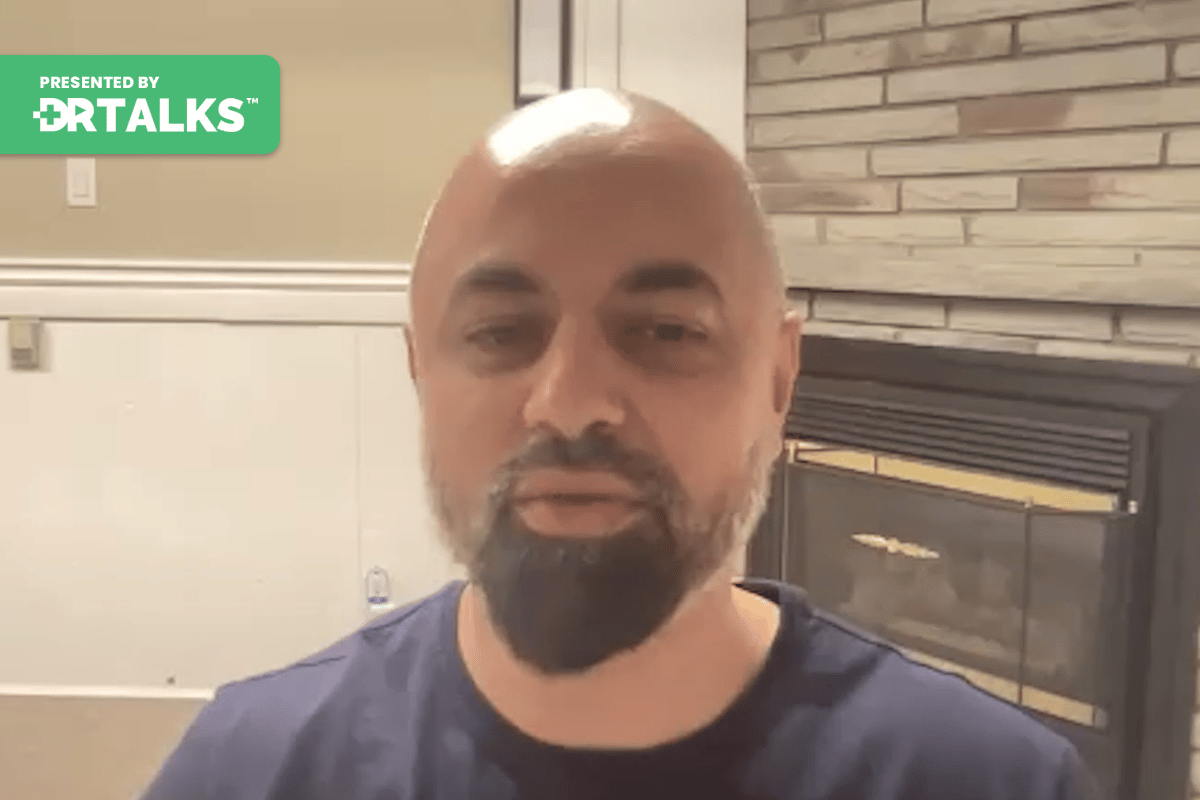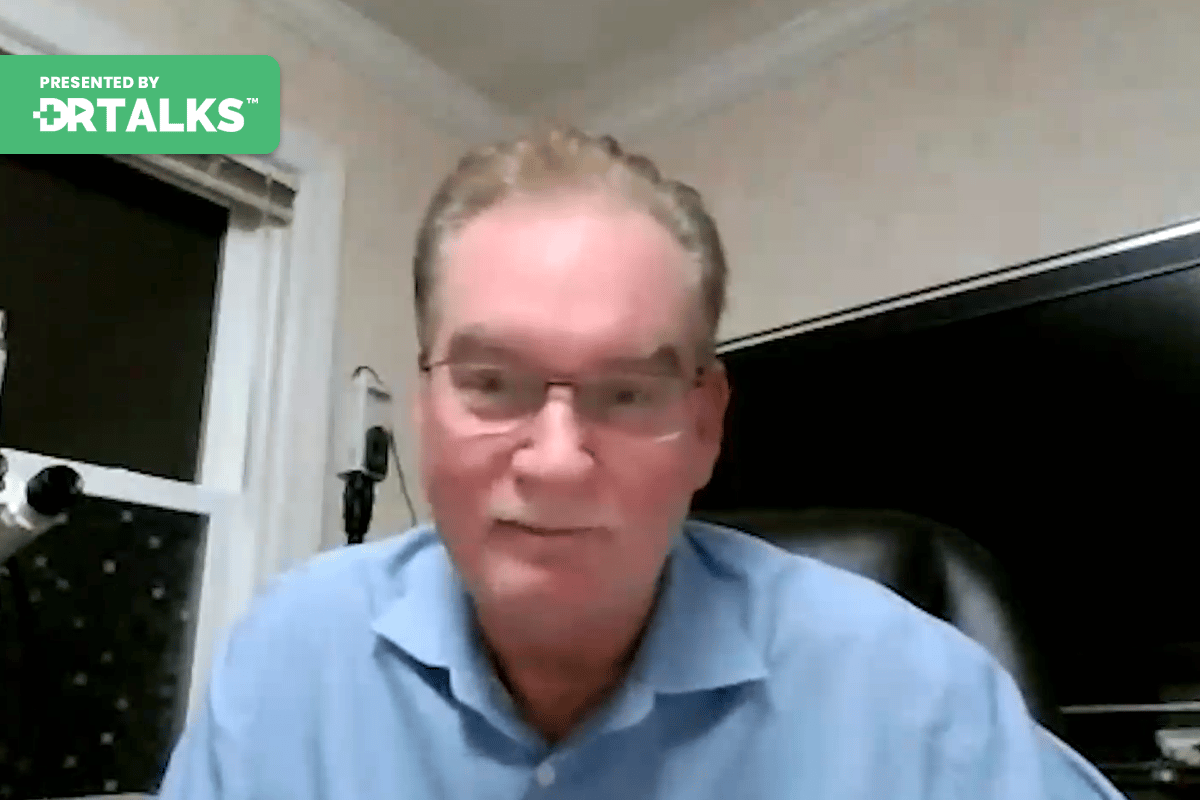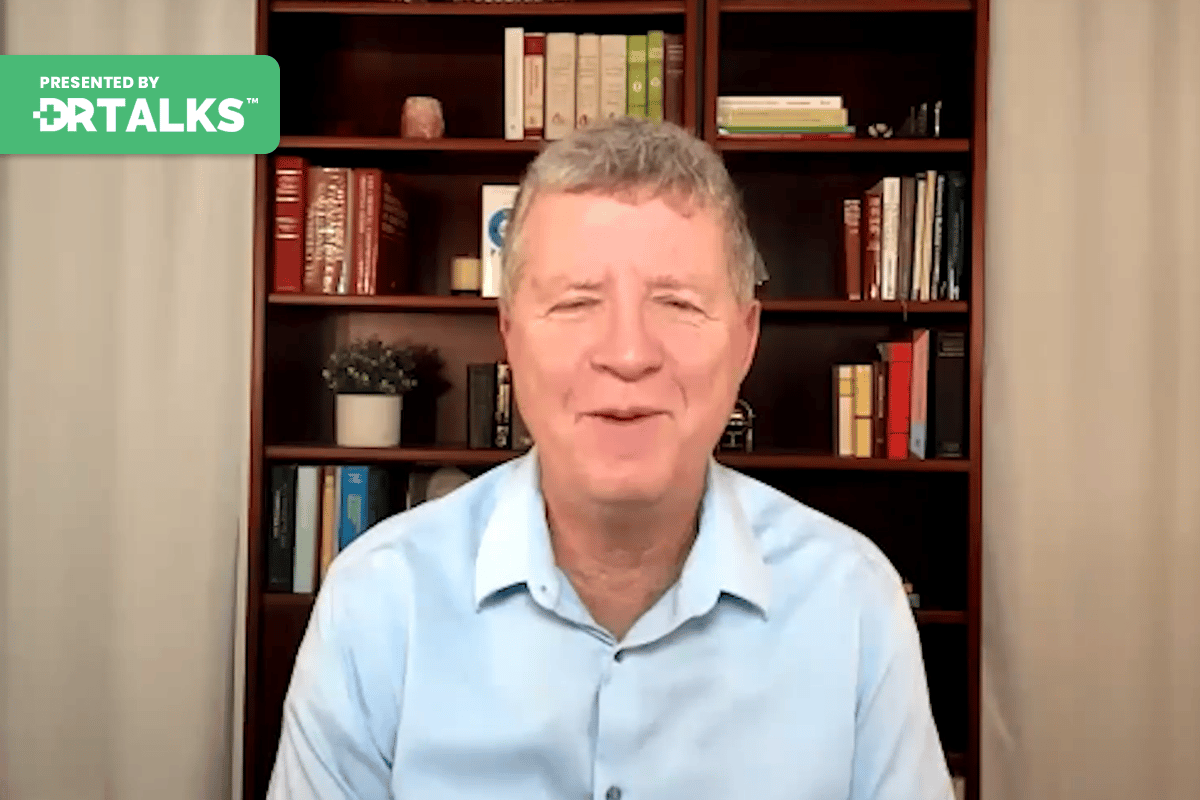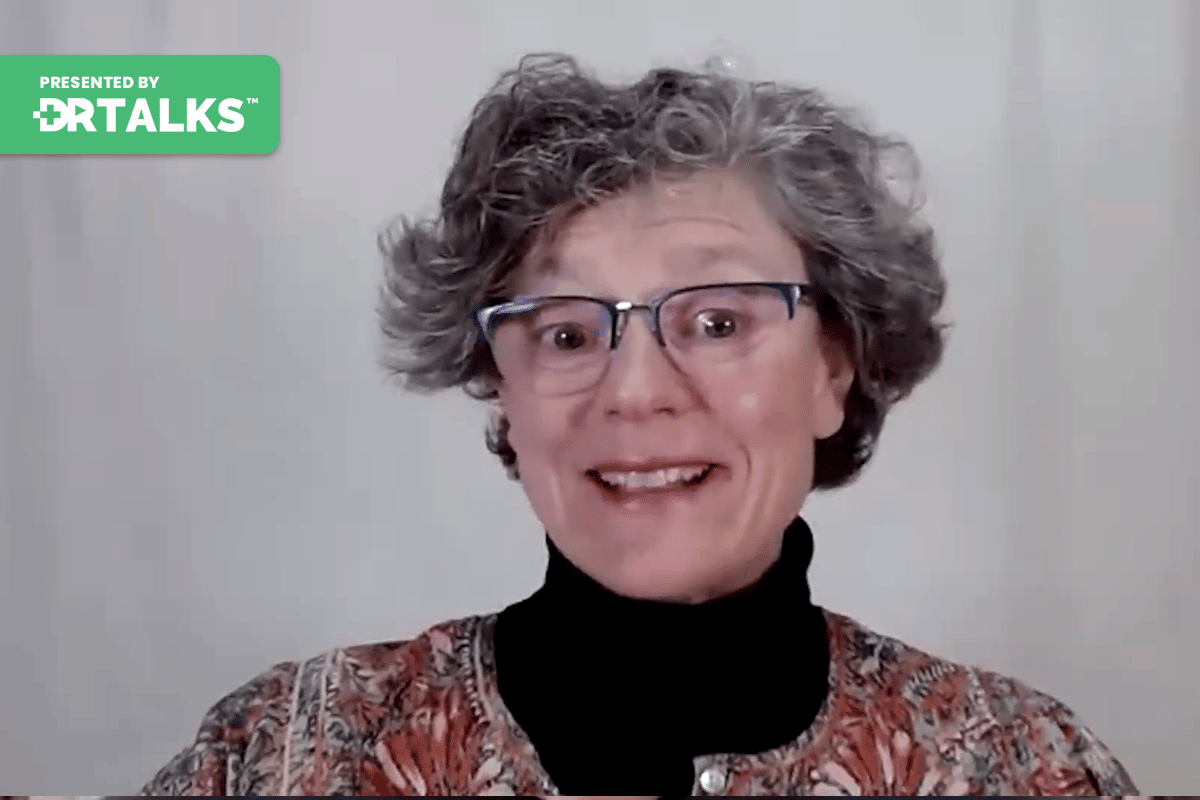Join the discussion below
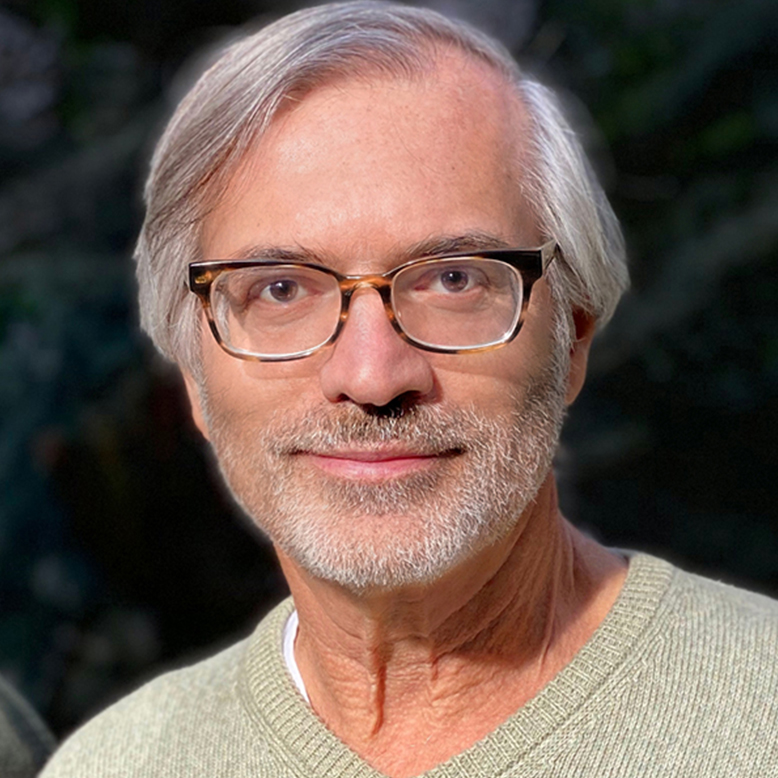
Eric Gordon, MD is President of Gordon Medical Research Center and clinical director of Gordon Medical Associates which specializes in complex chronic illness. In addition to being in clinical practice for over 40 years, Dr. Gordon is engaged in clinical research focused on bringing together leading international medical researchers and... Read More

Kashif Khan is the Chief Executive Officer and Founder of The DNA Company, where personalized medicine is being pioneered through unique insights into the human genome. With the largest study of its kind globally, The DNA Company has developed a functional approach to genomic interpretation overlaying environment, nutrition, and lifestyle... Read More
- Using your genes to know how to intervene and become more efficient in the healing process
- How individualized inflammation is and how you can support your own personalized genetic needs to lower inflammation
- The importance of the quality of the endothelium lining
Eric Gordon, MD
Welcome to another edition of Overcoming Long C0V!D and chronic fatigue. Today we’re gonna have a very interesting talk, we’re gonna talk a little bit about the risk factors at least seen through the lens of genetics. And with me is Kashif Khan he is the CEO and founder of the D. N. A. Company, this is where personalized medicine is being used to give us some insight into how we can really optimize our health. And he’s also the host of the unfilled podcast. I like that title. And you know Kashif you know had been an entrepreneur and unfortunately walked into the wall of toxic illnesses and did a lot of work and has now come back and through his own work and is helping you know, all of us stay healthier and hopefully live less toxic lives as we understand some of the risk factors that make us may be more susceptible to individual toxins and risks. So Kashif welcome, glad to have you here.
Kashif Khan
It’s a pleasure good talking to again. We remember discussing with you last year completely different topic but it was amazing you know, just sharing knowledge with you so ready to do it again.
Eric Gordon, MD
Yeah. Yeah. So so when I’m when I’m really interested, you know when we when we talked about having you on it was and I just love the way that the lens that you’re that you’re giving us which is basically you know, how can the emerging science, the emerging science of functional genomics, you know really help us deal with, you know, interpret the genes? Because we lots of companies are looking at genes. So how can you help us?
Kashif Khan
Yeah. Well, in this context of sort of long haul and chronic fatigue, it becomes very relevant. And that’s the reason that question of genetics versus functional interpretation. It’s the same thing as we say about medicine versus functional medicine. Medicine is, you know, when you’re sick call me and I’m gonna mask the symptom and successes that you’re not complaining about. Whatever the pain point is, any more functional medicine is. Let’s figure out why it happened in the first place. Right? And genetics went down this sort of path of being funded by pharma and looking for disease centric sort of narratives and solutions, which is really good for rare genetic conditions. If I have sickle cells, I need to solve that. I’m born with it. I haven’t but that’s a very small sliver of what we all deal with it. And in the context of what we’re going to talk about today, you know, we need to dive a little more functioning. So what does functional mean? It means that first of all, each gene standing alone doesn’t mean much, you have to understand and lay them out as per the biological processes we already understand. We already understand the hormone endocrine system. We already understand the cardiovascular system. We understand the neurochemicals in the brain.
So why are we then breaking it apart into these siloed separate conversations as opposed to the flow, that circadian rhythm or flow that we already know exists. That’s the first step of functional interpretation. Which is, let’s look at genes as per human biology, not for what the gene is standing alone as a job for. Right? And look at that path. The second layer is even then you’re going to get to this propensity based interpretation. And you only truly get to certainty if you also consider the epigenetics of the environment, nutrition and lifestyle. You know, I can have this great propensity towards Alzheimer’s with great sort of there’s a lot of things that I can look at that are not a single gene, but pathways and systems. But am I doing the things that are alone on that system? Am I doing the things like, for example, if it’s insulin response that happens to me, my problem. But I’m eating perfectly. So that never triggers, right? So the combination of this is what gets us to action ability, which is not just here’s your genetics. You have an 80% chance of long haul. Good luck. See you later. It’s like why? What do we do about it? Let’s with precision pinpoint what your problem is. And I’ll give you your plan specifically what you need. It’s been brought to that level of certainty now, which excites me because I see over and over and over again, all these people like I’ve hit a plateau. I haven’t known what to do for years and now all of a sudden this thing feels better. Right? So that’s sort of genetics versus functional genomics.
Eric Gordon, MD
Yeah. No, I love that. Yeah. Just realizing that these are system problems and you know and so many people look at one gene and think oh my God I’ve got the gene for X. I’m gonna get it I’m gonna die this way and it’s just not the way the body works. There’s you know there are a few 100 very very rare diseases were having the gene will get you but they are very very rare. They’re not what really gets us. The thing that gets us is the genes that debt I have to do with how we control inflammation which is what we’re going to talk about more or less I think today and what what what I think is is the underlying issue for how people wind up with long haul and and any of the other chronic chronic diseases especially I mean C. F. S. So you know what is some of the research in regards to viral infections and how the body responds to that.
Kashif Khan
So what we’ve seen, I mean we were chatting earlier and you were talking about the ace gene. Right? So if you don’t even know very baseline simple stuff if you don’t even know what version of the H. Gene you have, how do you know how your body deals with C0V!D the initial infection, right? We know that aces that sort of lock and key it connects and it allows the are needed to get deposited and make you actually sick. You know, forget about what puts you in the hospital with the actual flu symptoms. So we can very quickly determine how sick are you gonna get right to? What degree is this thing gonna put you into bed or put you on your, on your back for a couple weeks or you don’t even know you have it. People walking around a symptomatically that didn’t even get sick, right? So that the ability to even get infected then once you are infected, why is their variability and outcome? Why is their variability and severity? Well, ultimately, if you have a terrain, let’s call it, that is vibrant and thriving. Then when you throw something at it, it’s going to be less of a problem.
And you’ve seen this in your patients where you keep them at a certain level of health and when they get sick, it doesn’t mean much to them versus if you’re maintaining a terrain that’s already on the tipping point of collapse, then you throw something at it. That catalyst means a lot more to you and you can look at things like innate mitochondrial health. If you know that at the mitochondrial level, which is very easy to determine genetically sought to super oxide disputed, like what you’re actually doing in terms of anti oxidative response are your cells suffocating and choking oxidation.
Are you having the wrong habits? Suppose you don’t deal with oxidation? Well and you run on a treadmill every day and you’re putting yourself into oxidative stress completely the opposite of what your body is calling for. Right? That’s the person who is setting in that threshold, right? They may not be sick, but the cells are not ready to defend another threat. So it’s understanding at a cellular level and we can go on, there’s multiple things we can look at that would create a threat to the cells. So it’s understanding what are these three or four sort of inputs that lead to a load on the cells? What state do I think my cells are now in based on what my experiences have been right now. I know why next to grandma, grandpa or my cousin or whatever, we have the same genes. Why did I get so much more sick? Right. Why me? Because of your habits? Your lifestyle choices that are missed allying to what your body is capable of. Very easy to determine if we start to look at these pathways that support cellular health?
Eric Gordon, MD
Well, I’d like to look at some of them in particular but let me just just wanna, you know, restate something that I’m now saying regularly on these things, Something we talked about earlier is that, you know, we in our practice, we see lots of people with chronic fatigue and chronic Lyme and one the things that surprised me and also all the doctors that we’ve been talking to who had practice is full of people with these chronic illnesses, which mean on some level that their genetics are set up to not deal well with inflammation and these kind of stresses, but because they’ve been on the appropriate supplements over the years, even when they get C0V!D, we have not seen long C0V!D where we do see long C0V!D is people just as you were saying, is people who were pushing their systems and didn’t even realize it.
These were people who probably had, you know, a little longer mono than they realized that it was like when they were 18. So they kind of forgot that their bodies took a long time to get over it and and they’re still burning the candle a little bit from both ends more than they should, you know, as you said, or maybe they’re over exercising for their type, you know, for their genotyping away for what their body can handle and not supporting it in the way that hopefully they can learn through their genes. Those are the people who tend to get at least in our experience seem to be getting along C0V!D while our previously sick patients who are a perfect setup because they already have problems with dealing with inflammation, but because of their supplementation, we’re just not seeing it. I mean, again, this is unfortunately, you know, this is not data because it’s anecdote, but it’s a lot of anecdotes and there’s a lot of anecdotes.
Kashif Khan
So a lot of people that think about the body the way that we’re talking about and I’m talking about sort of functional medicine. Integrative practitioners, right? That will tell you the same story that my patient population and we’re the same by the way, I’ll use ourselves as another. We have a research lab where we custom compound nutraceuticals for the purpose of understanding how we manage gene expression. So, you know, I can’t sleep at night. It’s not give me some melatonin. It’s figure out why there’s not one why there’s multiple reasons why people can’t sleep. So now we figure out if we figure out the why, what are the ingredients that now are studied to up regulate gene expression or down regulate to allow that person to do that job. Whatever that thing is we’re talking about, right? So we, at any given time have about 200 people in this sort of rotating research. That’s what we can manage in terms of custom compounding and monitoring people. And we surveyed them when we got a little deep into C0V!D And out of the 280 responded saying that Yes, they had C0V!D and 100% of the 80 said that they had zero severity. It was just a flu that passed. Right? But now that doesn’t speak to population data where 30% have no symptoms, 30% or like a flu and 30% in the hospital. You know, that’s, that’s generalizing a little bit to an extreme. But we understand that there’s different buckets and we didn’t experience those buckets. 100 Of the 80 people out of the 200 that said Yes, I had C0V!D is that I had zero severity. It was the flu that past. And this was during sort of the first couple of waves where it was a little more aggressive also. So there’s a lot to be said about maintaining innate cellular health and getting your body resilient and ready to cope with whatever stone at you.
Eric Gordon, MD
Yeah, that’s impressive. I mean, because I said, we’ve seen lots of numbers, but you know, you know that nice little, that’s a nice little sample size. You know, 80 out of 200 makes sense. Symptomatic and, but zero with zero severity. Gotta, I mean again, I think you’re beginning to get to the level of data, you know, at least I’m impressed. And that’s really excite. So going going back just for a minute, why don’t you pick, you know, just some always, it’s always nice to have a concrete example, pick one or two. You know, whether it be actually sleep is not a bad place to start because sleep is such a basic important part for maintaining any part of health. And that’s often a place where people struggle. So how do you, you go back, what kind of jeans are you looking at and just give us some examples
Kashif Khan
And you know, just sort of reading to help everyone read between the lines a little bit and I’m sure this was covered in some of your other talks and interviews. But long haul C0V!D doesn’t have a single face, right? It’s not one thing. There’s not this pain point is no, it could be triggered in many different things. And what does that tell you what it tells you? Like you said, keyword information, the inflammation is there. But wherever I’m not doing well, that’s where it’s going to express, Right? So C0V!D doesn’t cause this C0V!D long haul C0V!D, it causes everything wherever that weak link is. That’s what’s gonna trigger. And the root of that is you put yourself into an inflammatory state that you couldn’t cope and now the trigger exposes. So sleep is one of them. So, literally right before this call coincidentally and serendipitously speaking to a gentleman about, and I usually don’t dive in clinically, but this is a person that we partner with, he’s a clinician himself. So he just asked for a favor.
Like let’s go to the call. I wanna understand this stuff and he had two issues anxiety and broken sleep, right, which he had never had before. So when you look at his innate genetics they did point towards this sort of poor serotonin response. So his ability to bind and utilize serotonin which is sort of your mood regulator right? Was dis regulated. He had, if you look at it genetically the easiest way to say that he had really short receptors that can bind it properly right? So he doesn’t experience that serotonin as it should be. And so whatever is going on, whether it’s good or bad it’s hard for him to respond as appropriate for that good or bad. The mechanism of that. So we think of serotonin as and mood as like it regulates your mood. It makes you feel a certain way. The mechanism that causes that is this reptilian response in our brain of how do I respond to stimulus? How does my brain prioritize stimulus meaning you and me are talking? We’re focused. We know what’s going on. If somebody walks by, do I notice or not? How am I right now? Right. So the people are serotonin dysregulated are constantly distracted by everything because their brain can’t prioritize that stimulus right? They doesn’t know what to focus on which means they’re irritable. Which means they’re distractible. Some people may say they have an A. D. H. D. But at the same time they have this propensity towards detail when they’re doing their work. They see all the teas and they dot all the I’s that other people maybe didn’t even notice we’re there. Right? So now that’s like the sort of superpower in the kryptonite of this profile.
Now, if you put someone to into a state where they have been exposed to an inflammatory insult, like C0V!D and they start to experience neural inflammation. That’s one of the places we’re going to express, depending what quality hardware you have. Right. Some people get it up here. Now, all of a sudden the compound effect of when I sleep, I there’s kind of two big halves. The first half is recovery. I get into deep sleep, my body, you know, Glymphatic drainage of the brain, lymphatic drainage, glued to the thigh on cleaning up all the mess of the day before the second half is let’s start getting ready for tomorrow. Let’s make my hormones, let’s make my neurochemicals. You start making stuff to get ready, right? It’s kind of like, it’s more nuanced than that. But those are sort of the two big halves. So the hormone that we know puts you to sleep is melatonin. You bind, it gets you into that state you fall asleep. What wakes you up is serotonin, right? So what’s meant to happen is the, you know, sunlight comes through the window, there’s this peachy glow when it goes to your eyelid and that color truly triggers the binding of serotonin and you’re supposed to then get up, right, just like our ancestors used to see the amber glow of fire at night and that’s what would trigger the binding of melatonin.
So we’re still wired to do what our ancestors did genetically on the inside. So for someone who’s dysregulated for serotonin when they’re in that second half and they can prioritize stimulus, everything triggers it’s time to get up. It’s too hot, it’s too cold. My wife just pulled on the blanket, the dog went down the stairs, Whatever is going on. Am I supposed to get up? No, back to sleep. Am I supposed to get up, go back to sea and they’re in and out in and out in and out, throw long haul on top of that and neural inflammation, which is what this gentleman is experiencing, it gets exaggerated. So he was kind of at a micro level feeling it didn’t really bother him. Now it’s like a chronic problem. I can’t sleep at night, right? And it’s not a direct C0V!D caused. I can’t sleep at night. You already didn’t have the ability to sleep at night. Now the epigenetic factor of the inflammation causing that neural inflammatory load is exaggerating that response. And now you’re noticing it right now it’s a big deal. Now it’s a problem. Now it’s a chronic issue. This was also driving his anxiety response, His inability to deal with serotonin and he’s, I believe he’s a dentist, you know? So now all of a sudden there’s this chronic, like, what do you call, like a high functioning anxiety. Everything matters, everything bothers me. I need to go do it, do it, do it, do it that’s also being exaggerated form and he’s so anxious he can’t get his work done. So you take this profile, we know what it means. This is the catalyst that takes him over the edge and also expressing is a chronic condition
Eric Gordon, MD
Wow. And so what did, I mean that was a beautifully laid out you know for people because I think that’s you know complex stories you know made simple I really appreciate. And so are there particular ways that you deal with the low serotonin and the just just give us a little flavor.
Kashif Khan
So the easy thing is we know that the gene is five H. D. T. L. P. R. And we know that five HTP regulates serotonin levels right? But that’s again masking the symptom. The root is the neural inflammation right? So we need to remove that load. So there’s multiple things happening. There’s an acute response of you need to block out the light, you need to wear earplugs, you need to have a separate blanket from your wife. You need to have perfect temperature zero stimulus. That’s one now that we’ve got you into a better environment where you can sort of thrive in your sleep. You now need to work on the actual inflammation right? And there’s I’m sure in these you’re gonna you’re gonna learn, right? So there’s a lot of choices but deal with that and the inflammation head to toe for him just happened to be this was the problem.
Eric Gordon, MD
Right. Right. Right. And then yeah. And the lack of sleep well then keep driving the issue like that. And so when you look at when you look at fatigue from this perspective, what how do you what are the grand pictures there? Obviously the sleep is one of them. But what else has happened?
Kashif Khan
So when it comes to fatigue, there’s kind of two halves to fatigue. There’s the actual fatigue meaning low energy. But then there’s also the lack of recovery which you know is part of what would make you feel fatigue. But people don’t don’t bucket that is the problem. So going back to mitochondrial health like mitochondrial function which is very easy to determine at the genetic level. If you don’t deal with oxidative stress well and you don’t deal with the glutathione pathway. Well to actually bind and get rid of these toxins that are coming out of the mitochondria oxidants as we call them. Then recovery is a problem. If you’re training and working out if you’re not sleeping properly. If you’re stressed right? The cells don’t rejuvenate and get back to their thrive state. But fatigue is also a problem because they’re not producing enough energy in mitochondria does multiple things. It creates the energy that store of energy at the A. T. P. That’s where it happens. So if your mitochondria not functioning properly well you’re going to be fatigued. Right? Again. Put on top of that scenario, C0V!D and you have this cell that’s already struggling and choking and suffocating.
Now having to deal with that also. Right? And it’s supposed to fight back with that thing when it’s already struggling here. And this is why we say the terrain, You know what are you putting C0V!D into? Is the terrain ready to fight that thing? Right? So all of a sudden fatigue isn’t so much about the feeling of fatigue recovery isn’t so much about the feeling of recovery. It’s how resilient is your mitochondria right now? And here’s one really interesting thing because we see that the older the person as we talked to the more pronounced this is as you age you continue to lose your mitochondria depletes. So by the time you’re 70 years old you lost 70% of your mitochondria. By the time you’re 80 years old you’ve lost 80% of your mitochondria. Right? So the body’s ability to fight back and that energy store is just not there anymore. And why does chronic disease set in when you’re older because you and then your body is fighting and it’s resilient and it can do the work. But all of a sudden you take away the soldiers and you know everything collapses on itself. So there’s things to consider their about innate cellular health and getting those cells into a thriving state. And the question is well what do I do? Genes allow you to figure out what that threat is and then focus on that. That’s your problem. This is your problem. Right?
Eric Gordon, MD
Can you I mean are there you know a few genes that that you tend to prioritize in when you’re looking at you know mitochondria and energy production.
Kashif Khan
Yeah so it’s sought to S. O. D. To write and then G. P. X. Which is sort of a sister in the process to anti oxidation. Then we look at G. S. T. T. One which is a glutathione jean as part of the growth ion family. Because if you do a good job of anti oxidation you still have to deal with the occident being put into the blood and being removed. Which is a glutathione process. So any one of these steps can be broken. Right. Then we look at methylation and methylation is drastically misunderstood and sort of underutilized genetically. And it’s because the M th fr gene as it’s known is the sort of central star of the methylation cascade. And there’s a lot of tests that will single it out and only look at that. And this is where you don’t know what to do. How do I action this? So I have the bad MTHFR so many people say well methylation is a cascade. It’s not a single gene, it’s actually a baton pass, there’s these genes that work in a cycle. I do my job, I pass it on, I do my job. And what are those jobs taking B. 12 and metabolizing it and getting it into the system taking B. Nine folate. Right? How do you then utilize full it? If your S. H. M. T. One gene is off then full, it isn’t gonna work for you folic acid, you need folic acid, very specific change. So if your m th fr is off, all you’re saying is that this sort of central star by methylation cycle is pointing to a problem. But where do I intervene that this big anti-inflammatory job that I do? Where do I intervene? Is it at S. H. T. M. One which is politic acid versus folic? Is it at fort? To which means do I actually take a sublingual B. 12 or in the stomach?
How do I actually metabolize? It is an MTR. MTRR. Do I need method, cobalamin 12 or do I need adenosyl? So what version do I actually need? This? Might give me a headache. This is gonna make me feel amazing. So now you can get very precise on how and where to intervene and precisely give your body exactly what it needs. Then what does methylation give you two things? It’s your core, call it in a nutshell anti inflammatory process. But it’s also managing all your gene expression. So genes get methylated and they expressed differently. So if your methylation isn’t working and your body is trying to fight something and your body is trying to turn on different processes by up regulating genes. It maybe isn’t doing that so well and it can’t send the troops in because the genes can express in an exaggerated form that they need to in that acute moment, right? We need to work harder right now. But I don’t have the right micro nutrients in my body so I can’t get these genes to express properly. That’s methylation so can be very precise about where to intervene and also in that fight, that anti inflammatory fight becomes a lot more efficient.
Eric Gordon, MD
Yeah that’s very helpful because I think people you really need to understand you know one the complexity but to how, you know, some of the complexity can be made a little simpler. And that that’s really important because you know, again reinforcing the idea that one gene is your is deterministic of your health. It’s just not true and you really each one of them as you said, they’re passing the baton they’re they’re parts of a pathway and they can reinforce each other very well. And so when people look at your test, you’re able to actually they actually get that information clearly of where they stand of which one of theirs is tends to be weaker and need support. Is that…?
Kashif Khan
Yeah, the whole idea is that we’ve mapped out the cascade right for these various systems. Whether it’s hormonal, whether it’s neurochemical, whether it’s cardiovascular, which is another big one we should touch on by the way, whether it’s methylation, whether it’s your various detox are anti-oxidative pathways. It’s not enough to just say I don’t do this job well where exactly which link of the chain is broken. Right? What do I need to do? Because you can also over supplement yourself. You can take things that are, you know, maybe burdening your system if your cells are already struggling and you throw more stuff at the mix, can’t utilize it to begin with. So you’ve got to be precise.
Eric Gordon, MD
Yeah. No, I think that’s a very important thing. I’ve seen too many people come in with what I call the shopping bag sign. You know, just full supplements. But you know, I just worry about actually taking that many capitals is probably not good for you as well as the fact that it’s just not working. So clean things up being more precise and what you’re taking is really excellent. And so and you mentioned that the cardiovascular because you know the thing with long C0V!D a lot of people do have cardiovascular symptoms that are not necessarily they’re not cardiovascular disease often they are just cardiovascular reactivity. So how, what kind of things are you measure and you look at.
Kashif Khan
Yeah. So this is a big one. It’s one of the easiest things to deal with. One of the easiest to predict because like you said, most cardiovascular disease isn’t a heart disease. Right? The heart is what is suffering in struggles, but it’s usually an arterial disease. It’s usually the arteries that are struggling. So what we can determine with great certainty is the quality of your indoor thallium. Right? So that inner lining of the blood vessel, How prone is it to inflammation? When we say,
Eric Gordon, MD
Let me just start. I’m just going to interrupt it. But I just want to say people if you’re listening listen really well because the endothelium and the inflammation in the endothelium by most of the theories that we’ve been being exposed to is where the rubber meets the road in long C0V!D.
Kashif Khan
So it’s probably the number one thing that happens, right? It’s the number. And guess what? Here’s the thing when we look at our data, when somebody has the optimal indoor helium infrastructure, they have the top resiliency. That’s less than 5% of people. Why is cardiovascular disease the number one killer? Why did it kill? I think it’s like 18 million people last year. Right. Why is 50% of the American population expected to have a cardiovascular disease? It’s because most of us don’t have good into helium quality that innate cellular structure just isn’t good. That’s the norm. That’s the default. We don’t have it. Why? Because the reality of our environmental exposures or stresses or lack of sleep is not the way our ancestors lived. So they didn’t need that level of resiliency. Right. They didn’t have toxic substrates that they were breathing in as they were in traffic or as they were gardening and breathing in pesticides or as they were golfing and breathing in pesticides or they’re cleaning stuff for their countertop.
That wasn’t part of reality. So all this stuff that we’re now ingesting both through our breath and through our gut and even through our skin and sometimes causing inflammatory insults internally. We just haven’t yet genetically caught up to the fact that this is how we now live. We are wired like our ancestors and our ancestors didn’t have to cope with that. So the majority of people we see are at minus 50% capacity to deal with endothelium information. Majority. Right. That’s kind of the expectation when I open up your D. N. A. Report, I expect to see 50% or less ability to cope with inflammation here. That paper thin hardware as opposed to stay in the steel and resilient. We are surprised when we see a good quality. So this is why, first of all in a helium head to toe, their vascular tourism in every part of your body. So this affects everything. But it’s also why it’s the most prolific because most people just aren’t doing well here, right?
Eric Gordon, MD
Yeah. You know and the other addition is that you know we were designed to survive infections. So the inflammatory response is a real pro survival response in a world where there’s a lot of regular injury and you know if you’re cutting yourself every day out in the woods you better have a really good you know pro inflammatory response to take care fix the injury. Kill any of the bugs they got in there. You know and that’s but on the other hand now we live in a world where we’re not getting enough inflammatory signals except from occasional viruses like we get overwhelmed. But our body is getting triggered by all these constant low level inflammatory singles that you were talking about and that’s the environment. That’s the genetic mismatches that were made to survive 5000 years ago. Not for you, not for the last 150 years which we’ve just changed the world.
Kashif Khan
And the reality is that people often don’t get when you look at the big picture, our D. N. A. Is actually 200,000 years old. Right? So when you think of what we’re wired for the habits of people of 200,000 years ago until today. The reality of the 150 years you’re talking about is a tiny blip in that 200,000 year window. Look at, just think about that would visualize. That’s right. And so who are your ancestors? What are you wired for? And exactly. We are wired for dealing with acute inflammatory response to acute problems, this chronic ongoing drip of constant inflation. That’s not what we were wired for. So what this is why there’s so much cholesterolemia. Because when you get inflammation in your endothelium, in your arteries, cholesterol is one of the hormones that your body uses to reduce the inflammation, right? It’s an actual tool that’s deployed to fight the inflammation. And the amount of oxidative stress were under gets what happens when cholesterol meets oxidation or toxicity, it gets oxidized itself and it hardens and it can’t move, it gets deposited. You get that build up and we label this disease and cholesterolemia But it’s actually in the endothelium information, right? So now if you know, you have this head to toe information from long haul C0V!D, then cholesterol becomes a problem and other things become, so this is kind of ripple effect. So deal with the root, get right to the root and deal with that.
Eric Gordon, MD
And when you look at those, you know, you mentioned you know, for the mitochondria? You know, three of the genes that you tend to think of. What are you looking at in the endothelial function. What you’re what are you testing?
Kashif Khan
So, we look at a few things, there’s a gene locus called 90 to 1 and there’s three locations on that where we look for a snip, you know, this spelling error. And in that there’s a potential of, you know, any one of those three being off, most people are off in two locations, so, like 60, you know, negative outcome. Right? But again, knowing that. So, one thing I should say off the bat, anything that we can determine genetically, we can, we also know exactly what to do about it. So it’s not what
Eric Gordon, MD
I was gonna say. So, so for this one, what does this gene do when it works well? And what is it failing to do?
Kashif Khan
So, in a nutshell determines the robustness of the glycocalyx and the endothelium, what quality hardware do you have? Right. So, it’s instructing genes are instructions that tell your body what to do. So, the endothelium is now looking to this instruction to say, how do I build myself and I don’t know myself that well. So, it’s kind of a thinner called cellular structure, which is more important information, right?
Eric Gordon, MD
That’s the, like, okay, Glycocalyx is just that thin lining of the endothelium, just so. Exactly.
Kashif Khan
Right? So now the good news is if we know that that’s you we also know exactly what to do about it. So you don’t need this guesswork, this trial and error. So we don’t and this is a misnomer about genetics. It’s like, Oh, I’m gonna be told something. I don’t want to know what we’re telling you is. Here’s what we need to work on and we actually know what to do about it. So, let’s get ahead of these problems. Right? So anyways, to answer your question again, 90-1 is one of them. Then we look at those three which is really regulating nitric nitric oxide delivery. Right? So we can determine sort of vessel dilation and how you deal with blood pressure. And nitric oxide delivery is one of those key factors for, you know, arterial health in general and cardiovascular health in general. So if you’re not doing well there, you need to be supplementing.
You need to be adding material regimen to deal with. Just that one specific thing, the ace gene that you mentioned, which talks about, you know that that lock and key for C0V!D also regulates hypertension, right blood pressure flow. So if you’re not doing well there, you also know that’s another factor that may be a load to this bad quality in helium. Right? So we can start to look at these. The other thing is so we 33 is the ideal aleel what you want to have. And then once you get into force, you start to point to things like Alzheimer’s and dementia and really what we’re talking about is the efficiency of lipid transport. So if you’re not doing that. So well then not only am I getting inflammation. Not only is my body deploying cholesterol is a hormone, but I also don’t do a good job of managing cholesterol so that its gonna compound that problem. So this and this is what we mean by functional interpretation. Not one gene, one does one thing, how does biology actually work? And now let’s look at what gene does that job and what gene does that job. And we can be very certain about where to intervene.
Eric Gordon, MD
Well, no, that’s fascinating. And the cholesterol world is one that someday we’ll do a real deep dive in because my personal feeling is that cholesterol is more of a response to inflammation. And the Chronicity is what the problem is than anything else. But as far as, you know, when you’re looking at long haul and you know, we’ve seen such variability. Some people have, you know, you know, some fatigue, some people have, you know, fatigue that has changed their lives. Some people have a little tinnitus and some people just can’t think straight anymore. You know, I mean we go through there’s so many different what we call the medicine phenotype, there’s so many different ways that this shows up. So in your using your your testing, how have you been able to like, you know, kind of parts this a little bit and help people understand why they’re where they are at.
Kashif Khan
The way we think about the body and a problem. Like for example, C0V!D, long haul C0V!D is a problem. We’re not looking for that problem in the genes. That’s what genetics does. Here’s the C0V!D gene, here’s the Alzheimer’s gene, but the body doesn’t work like that. Just data that on some average basis seven out of 10 people found some problem. But we don’t know why. Right? What we’re saying, let’s get to the y. So when we think about a problem, like long haul, we’re not looking for the long haul in the genes, what we’re looking for is what job does your body not do? Well, write a gene is an instruction that tells yourselves what to do. If an instruction is either over or under prescribed, then we know you’re over or under doing that job. Now, that clearly points to a problem. For example, it could be hormones, right?
We know that testosterone is implicit in the how prolific C0V!D is right, when your testosterone, that is why young men are getting myocarditis, this is why you see these power athletes that are at their prime that ended up in the ICU, right? Testosterone drives that. Unfortunately, it’s one of the things that the cool factor, the the severity of C0V!D. So if we can determine in your hormone cascade that you make a lot of testosterone, that’s where we’re gonna go? We’re gonna say perhaps this is the thing that’s driving that ability for to C0V!D to thrive and cause you that information and take you so far over the edge. Right. That’s one example. Then we can look at your neural pathways and how you deal with neurochemicals and maybe you just have the ability to take on a lot more stress and you push yourself a little more and more reward seeking. For example. Right.
And on top of that, maybe you deal with emotion at a degree where you truly imprinted, right? There’s some people that recall emotionally and some people recall intellectually. So, the people that recall emotionally tend to use that as their primary tool, which means that things mean a lot things cause them a lot of pain, you know? And so when you have that combination with the drive of reward seeking behavior, then you’re already stressing your brain to a degree where you’re ready for that catalyst to push you over the edge. Right. So it’s not that we’re looking for long haul signals, we’re looking for. What does your body not do well? Or what does it do? A little too? In this case it’s doing it too well in this case it wasn’t doing it well. Right? So now and then that points to now we understand why you feel the way you feel, right? And this is why long haul can express in so many different ways. What we’re saying is inflammation, that’s it inflammation now. Where is it gonna poke out its ugly nose depending what genetic job you don’t do well.
Eric Gordon, MD
I like that was that was well said Kashif. I mean, you’re you’re you’re bringing up the essentials of you know how to dance with the body. You know, I mean like getting, getting out of that linear, you know, like here take this for that. But you know just how we’re going to rebalance the system, seeing your strengths, seeing your weaknesses and knowing that even sometimes your strengths sometimes have to be moderated, you know, to keep the system in balance that’s exciting work. And you know, after I like it sounds like, you know, and you’re developing, I can tell like we spoke about a year ago and it sounds like you’re you’re really building on the experience and which is which is nice to see.
Kashif Khan
Yeah, the research never stops. So the interesting thing about genetic testing is your genes don’t change, right? So as a business, it’s like, okay, I you run a genetic test now what? Right, So our intention, what ends up happening, all these genetic testing companies become data selling businesses because I don’t need to test you again. So I’m gonna sell your dates. We said instead of doing that, let’s be the inside company. Let’s just never stop researching and learning. And then every time you log into the report, you’re learning something new because we’ve added more information, right? But beyond that, we also have a clinical level, know how to intervene. Our coaches are clinicians all that know how to support this stuff and working with amazing partners like you and the work that you do and how do we collaborate and make this stuff better and all of us learn. So yeah, we we took this path that just never stopped learning, never stopped developing. Always make it better. I want to log into it myself in six months and learn something that I didn’t learn and we’re gonna keep doing that is great.
Eric Gordon, MD
That’s so nice to hear because it’s a creative way to serve, you know, like you say. And instead of just like getting people’s data and selling it, I like it. So I just want to thank you so much because again, you know, while we’re looking at this issue, you know, long C0V!D really brought home chronic illness to the world. You know, we’ve been treating the chronic fatigue and chronic line people for a long time and it’s like, this has been a terrible illness, but just the way everybody, you know, like the research community is standing up and I know it’s very way too slow for the patients, popular patients who are sick, but it’s changing and hopefully more people will hook into the work that you’re doing and really, you know, I’m looking forward to when we just have the idea of chronic inflammatory disease is an old fashioned idea be a while, but but but you know, there was a time when, you know, nobody, nobody thought that, you know, having pneumonia, you know, when you were old was anything less than a death sentence. And now it’s not usually not such a big deal. So hopefully someday we’ll get to that same level with these chronic illnesses, they’ll be for sure we’re getting there. So thank you, thank you for your time. I really appreciate it.
Kashif Khan
Pleasure. Thank you.
Downloads

